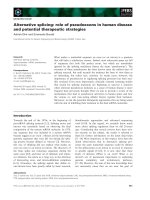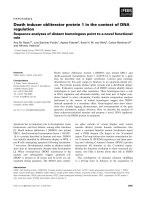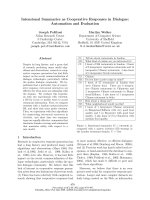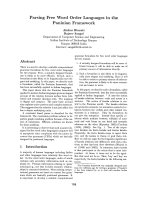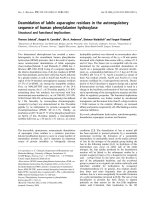báo cáo khoa học: "Hodgkin lymphoma treatment with ABVD in the US and the EU: neutropenia occurrence and impaired chemotherapy delivery" potx
Bạn đang xem bản rút gọn của tài liệu. Xem và tải ngay bản đầy đủ của tài liệu tại đây (345.26 KB, 6 trang )
SHOR T REPOR T Open Access
Hodgkin lymphoma treatment with ABVD in the
US and the EU: neutropenia occurrence and
impaired chemotherapy delivery
Matthias Schwenkglenks
1*
, Ruth Pettengell
2
, Thomas D Szucs
1
, Eva Culakova
3
, Gary H Lyman
3
Abstract
Background: In newly diagnosed patients with Hodgkin lymphoma (HL) the effect of doxorubicin, bleomycin,
vinblastine and dacarbazine (ABVD)-related neutropenia on chemotherapy delivery is poorly documented. The aim
of this analysis was to assess the impact of chemotherapy-induced neutropenia (CIN) on ABVD chemotherapy
delivery in HL patients.
Study design: Data from two similarly designed, prospective, observational studies conducted in the US and the
EU were analysed. One hu ndred and fifteen HL patients who started a new course of ABVD during 2002-2005 were
included. The primary objective was to document the effect of neutropenic complications on delivery of ABVD
chemotherapy in HL patients. Secondary objectives were to investigate the incidence of CIN and febrile
neutropenia (FN) and to compare US and EU practice with ABVD therapy in HL. Pooled data were analysed to
explore univariate associations with neutropenic events.
Results: Chemotherapy delivery was suboptimal (with a relative dose intensity ≤ 85%) in 18-22% of patients. The
incidence of grade 4 CIN in cycles 1-4 was lower in US patients (US 24% vs. EU 32%). Patients in both the US and
the EU experienced similar rates of FN across cycles 1-4 (US 12% vs. EU 11%). Use of primary colony-stimulating
factor (CSF) prophylaxis and of any CSF was more common in the US than the EU (37% vs. 4% and 78% vs. 38%,
respectively). The relative risk (RR) of dose delays was 1.54 (95% confidence interval [CI] 1.08-2.23, p = 0.036) for
patients with vs. without grade 4 CIN and the RR of grade 4 CIN was 0.35 (95% CI 0.12-1.06, p = 0.046) for patients
with vs. without primary CSF prophylaxis.
Conclusions: In this population of HL patients, CIN was frequent and FN occurrence clinically relevant.
Chemotherapy delivery was suboptimal. CSF prophylaxis appeared to reduce CIN rates.
Introduction
Combination therapy with d oxorubicin, bleomycin, vin-
blastine and dacarbazine (ABVD) is the standard che-
motherapy regimen for patients with Hodgkin
lymphoma (HL) [1-3]. Myelosuppression, in par ticular
neutropenia, is common during ABVD treatment [2].
Chemotherapy-induced neutropenia (CIN) can lead to
febrile neutropenia (FN), which is associated with con-
siderable morbidity, mortality and costs [4]. Standard
care for the majority of FN patients requires hospitalisa-
tion and administration of intravenous antibiotics [5,6].
Neutropenic events often result in dose delays and
dose reductions, leading to impaired chemotherapy
delivery which has been associated with decreased survi-
val in certain types of cancer [7-10], indicating that opti-
mal intensity of chemotherapy treatment can improve
patient outcomes [8]. Colony-stimulating factors (CSFs)
have been shown to reduce the incidence and severity of
neutropenic events across a broad range of malignancies
and regimens and also to support the delivery of full
chemotherapy dose intensity [5,11].
In patients with HL, the effect of ABVD-related neu-
tropenia and neutropenic c omplications on chemother-
apy delivery are poorly documented [2,12]. Two
similarly designed, prospective, observational studies
were conducted in the US [13] and Europe [14] to
* Correspondence:
1
Institute of Pharmaceutical Medicine, University of Basel, Basel, Switzerland
Full list of author information is available at the end of the article
Schwenkglenks et al. Journal of Hematology & Oncology 2010, 3:27
/>JOURNAL OF HEMATOLOGY
& ONCOLOGY
© 2010 Schwenkglenks et al; licensee BioMed Central Ltd. This is an Open Access article distributed under the terms of the Creative
Commons Attributio n License ( s/by/2.0), which permits unrestricted use, distribution, and
reproduction in any medium, provided the original work is properly cited.
assess the incidence of neutropenia in patients under-
going chemotherapy. Here we present a subgroup analy-
sis of HL patients f rom these studies. The primary
objective was to assess the effects of neutropenic com-
plications on the d elivery of ABVD chemotherapy. Sec-
ondary objectives were to investigate t he incidence of
CIN and FN in patients with HL undergoing ABVD
chemotherapy and to compare US and EU practice with
ABVD therapy in HL.
Methods
Two similarly designed, prospective, observational stu-
dies [13,14] enrolled patients with solid tumours or lym-
phoma initiating a new course of chemotherapy, with at
least 4 cycles planned, during the period 2002-2005. In
the US, a total of 4458 patients were recruited from 115
community practices. In t he EU, a total of 749 patients
were recruited from 66 clinical centres in Belgium,
France, Germany, Spain and the UK.
Patients eligible for inclusion in this subgroup analysis
were adults aged ≥ 18 years about to start a new course
of ABVD (patients in whom doxorubicin was replaced
with epirubicin were also allowed). In the US study,
patients had a minimum life expectancy of at least 3
months. In the EU study, patients had to be HL stage
IB-IV. Prior chemotherapy and concurrent radiation
therapy were permitted. Key exclusion criteria were: use
of antibody-based or cell-based immunotherapi es, a his-
tory of stem-cell or bone-marrow transplantation and
HIV infection. Additionally, the US study excluded
patients diagnosed with myeloma or treated for active
infection and did not allow participation in double-blind
clinical trials. Patients in the EU were excluded if they
had conditions causing neutropenia, malignant condi-
tions with myeloid characteristics, or active infection
within 72 hours prior to the start of chemotherapy.
Concurrent participation in phase I/II clinical trials was
not permitted. Ethical approval was obtained for all cen-
tres and all participants provided informed consent.
Data were merged and variable definitions reconciled
to form a single, pooled dataset. Body surface area was
calculated using the Mosteller formula [15]. Delivery of
chemotherapy was assessed by considering the propor-
tion of patients that received relative dose intensity
(RDI) ≤ 85% of the planned or standard dose intensity
and by documenting the occurrence of dose reductions
> 10% and dose delays > 3 days. As delivery of vinblas-
tine is unlikel y to be affect ed by neutropenia, this agent
was excluded from the calculation of RDI and dose
reductions. In the US study, blood counts were drawn
at the beginning of each cycle and at mid-cycle, for up
to 4 cycles of treatment. In the EU study, a blood count
at the expected (protocol d efined) absolute neutrophil
count (ANC) nadir was required in cycle 1. Centres
were also required to record all blood counts taken dur-
ing each patient’s chemotherapy treatment. Grades 3
and 4 CIN were defined as an ANC < 1000/mm
3
and
< 500/mm
3
[16], respectively, and FN as ANC < 1000/
mm
3
in combination with site-reported fever above
38°C and/or infection. Primary CSF prophylaxis was
defined as C SF use in the first cycle of chemotherapy
before a documented grade 3-4 CIN occurred or
denoted as primary prophylaxis by the site.
Due to the limited sample size, analyses were predo-
minantly descriptive. Univariate associations between
variables were explored in the pooled dataset. Associa-
tions of binary data were expressed as relative risks with
accompanying 95% confidence intervals. Significance
testing was based on Fisher’s exact test (2-sided) due to
smal l sample size, which explai ns some apparent incon-
sistencies between p values and confidence limits.
Results
Patient characteristics
A total of 115 HL patients (68 US patients, 47 EU
patients) met the eligibility criteria and were included in
the analysis. T he age ra nge was 19-83 years (medi an 36)
in US patients and 18-74 years (median 34) in EU
patients; 49% of US patients and 38% of EU patients
were female. US patients had slightly higher body sur-
face area and higher incidence of stage III/IV disease
than EU patients a nd were more often pre-treated with
radiotherapy (Table 1). Eastern Cooperative Oncology
Group performance status was similar between US and
EU patients and no patients had prior chemotherapy.
Treatment characteristics
In most patients, 4-5 or 6 cycles of ABVD were pla nned.
In the US and the EU, median planned dose intensities
(expressed on the basis of actual body weight) met the
ABVD standard of bleomycin, 5 units/m
2
/week; doxoru-
bicin, 12.5 mg/m
2
/week; dacarbazine, 187.5 mg/m
2
/week;
and vinblastine, 3 mg/m
2
/week. Actual planned dose
intensities deviated in a number of patients and resulting
means were margina lly higher in the EU patients (Ta ble
1). One US patient (1.5%) and three EU patients (6.4%)
received epirubicin instead of doxorubicin (EBVD).
The percentage of patients receiving CSF overall and as
primary prophylaxis was higher for US patients (any CSF
use: US 78% vs. EU 38%; primary CSF prophylaxis: US
37% vs. EU 4%). A ntibiotic use was similar between the
two populations (any antibiotic use: US 41% vs. EU 49%;
primary prophylaxis with antibiotics: US 13% vs. EU 17%).
Chemotherapy delivery
Dose delays > 3 days were more frequently observed in
EU patients and dose reductions > 10% were more fre-
quent in US patients (Figure 1). Chemotherapy delivery
Schwenkglenks et al. Journal of Hematology & Oncology 2010, 3:27
/>Page 2 of 6
was suboptimal in 18-22% of patients (RDI ≤ 85% of
ABVD standard). Comparison against the actual planned
dose intensity for each individual patient led to a very
similar result.
Incidence of neutropenia and FN
Patients in b oth the US and the EU experienced similar
rates of FN in the first cycle of chemotherapy (US 7%
vs. EU 9% EU) and across cycles 1-4 (US 12% vs. EU
11%). The incidence of CIN in cycles 1-4 was lower in
US patients (Figure 2). US patients had a mean ANC
nadir of 2000 ± 2300/mm
3
in the first cycle compared
to EU patients whose mean ANC nadir was 1300 ±
1000/mm
3
in the first cycle.
Factors associated with chemotherapy delivery in the
pooled dataset
The relative risk (RR) of dose delays > 3 days was
1.54 (95% confidence interval [CI] 1.08-2.23, p =
0.036) for patients with vs. without grade 4 CIN.
There was no evidence of an association between the
presence of grade 4 CIN in any cycle and dose reduc-
tions > 10% or RDI ≤ 85% of planned/standard. Simi-
larly, there was no evidence of an association between
grade 4 CIN in cycle 1 and dose delays, dose reduc-
tions or RDI ≤ 85% of planned/standard. CSF primary
prophylaxis was not associated with dose de lays > 3
days, dose reduction > 10% or RDI ≤ 85% of planned/
standard.
Table 1 Patient, disease and treatment characteristics
Characteristic US (N = 68) EU (N = 47)
Age in years, mean ± SD (range) 40.9 ± 16.2 (19-83) 37.9 ± 16.5 (18-74)
Female gender, N (%) 33 (48.5) 18 (38.3)
Race, N (%) Caucasian/white 54 (79.4) 46 (97.9)
Black 10 (14.7) 0 (0.0)
Other 4 (5.9) 1 (2.1)
BSA at baseline in m
2
, mean ± SD (range) 1.94 ± 0.26 (1.42-2.53) 1.85 ± 0.21 (1.41-2.28)
ECOG status, N (%) 0 47 (69.1) 30 (63.8)
1 20 (29.4) 14 (29.8)
2 1 (1.5) 3 (6.4)
Disease stage
1
, N (%) I 8 (12.1)
2
5 (10.6)
II 30 (45.5)
2
28 (59.6)
III 23 (34.8)
2
8 (17.0)
IV 5 (7.6)
2
6 (12.8)
Prior radiotherapy, N (%) 6 (8.8) 0 (0.0)
Baseline WBC in 10
3
/mm
3
, mean ± SD; median 9.4 ± 4.9; 7.8 9.5 ± 3.8; 8.4
Baseline ANC in 10
3
/mm
3
, mean ± SD; median 6.5 ± 3.3; 5.3
2
7.2 ± 3.6; 6.6
Diabetes, N (%) 8 (11.8) 0 (0.0)
Cardiac comorbidity, N (%) 0 (0.0) 2 (4.3)
Planned dose intensity in mg/m
2
/week, mean ± SD; median
Bleomycin 4.9 ± 0.9; 4.9 5.3 ± 1.2; 5.0
Doxorubicin 12.5 ± 1.9; 12.3 12.8 ± 2.7; 12.4
3
Dacarbazine 184.0 ± 29.5; 183.6 198.3 ± 50.2; 186.7
Vinblastine 3.0 ± 0.5; 2.9 3.2 ± 0.8; 3.0
Planned cycle number, N (%) ≤ 3 0 (0.0) 2 (4.3)
4-5 29 (42.6) 16 (34.0)
6 38 (55.9) 26 (55.3)
≥ 8 1 (1.5) 3 (6.4)
Planned cycle length in days, N (%) 14 7 (10.3) 5 (10.6)
21 5 (7.4) 2 (4.3)
28 56 (82.4) 40 (85.1)
BSA body surface area; ECOG Eastern Cooperative Oncology Group; WBC white blood cell count; ANC absolute neutrophil count.
1
US: based on American Joint Committee Cancer staging; EU: based on Ann Arbor staging.
2
N = 66 due to missing values.
3
N = 44 as 3 EU patients received epirubicin.
Schwenkglenks et al. Journal of Hematology & Oncology 2010, 3:27
/>Page 3 of 6
Association of CSF prophylaxis and neutropenic events in
the pooled dataset
Patients receiving CSF primary prophylaxis were less
likely to develop CIN than patients who did not receive
CSF primary prophylaxis. The RR of grade 4 CIN in any
cycle was 0.35 (95% CI 0.12-1.06, p = 0.046) for patients
with vs. without primary CSF prophylaxis, and the RR
of grade 3 or 4 CIN in any cycle was 0.42 (95% CI 0.23-
0.76, p < 0.001). There was also a reduced risk of grade
3 or 4 CIN in cycle 1 for patients with vs. w ithout CSF
prophylaxis (RR 0.40, 95% CI 0.19-0 .83, p = 0.004).
There was no evidence of an association between CSF
primary prophylaxis and incidence of FN in cycle 1 or
cycles 1-4. In cycle 1, FN incidence was 7% in 27
patients with CSF primary prophylaxis and 8% in 88
patients with no CSF primary prophylaxis (RR 0.93, 95%
CI 0.21-4.22, p = 1.000). In cycles 1-4, corresponding
incidences were 15% and 10% (RR 1.45, 95% CI 0.48-
4.33, p = 0.500). The other univariate associations con-
sidered were not statistically significant.
Discussion
This study assessed the impact of CIN on ABVD che-
motherapy delivery in HL patients in the EU and the
US. Baseline characteristics were similar in both groups
although US patients had a more advanced disease state.
In both EU and US patients, CIN occurrence was sub-
stantial and the observed FN incidence of 11-12% was
considerably higher than the 4% reported in current
European Organisation for Research and Treatment of
Cancer (EORTC) guidelines [5]. EORTC guidelines are
based on a literature review of clinical trial data and
under-reporting of febrile events has been noted to be
common in randomised controlled trials [17] . This
study is the firs t multi-centre investigation of neutrope-
nic event incidence in general populations of HL
patien ts treated with ABVD. Thre e retr ospective single-
centre studies have also addressed this topic [18-20].
Populations studied were similar to ours with respect to
median age an d grade 3/4 CIN risk per patient. How-
ever, grade 3/4 CIN risk per patien t was n ot available
from Evens et al. [18], and in the single-physician
experience (with no CSF use) reported by Boleti and
Mead, the proportion of stage III-IV patients was only
13% [19]. Overall FN incidence was 10%, 5-9% and 5%
in the studies by Chand et al. (N = 81) [20], Evens et al.
(N = 84) [18] and Boleti and Mead (N = 38) [19],
respectively. These findings are not incompatible with
our results, considering that retrospective data may be
affected by incomplete recording. In addition, practice
patterns can differ, and chance effects may play a role in
small patient samples.
In both the US and EU populations, chemotherapy
delivery was subo ptimal with 18-22% of patient s receiv-
ing RDI ≤ 85% compared to standard/planned. As the
importance of ABVD dose intensity in determining
remission and survival has not yet been defined [2], the
clinical impact of this suboptimal ABVD delivery is n ot
known. However, the data highlight that impaired che-
motherapy delivery remains a problem in everyday clini-
cal practice, although single centres may achieve very
high average chemotherapy dose intensity [18]. Univari-
ateanalysisshowedthatgrade4CINincreasedtherisk
of dose delays > 3 days; however, the small patient num-
bers in each data set did not allow for efficient
Proportion of patients (%)
22
18
22
41
18
21
9
57
0
20
40
60
80
100
Dose delay
>3 days*
Dose
reduction
>10%*
¶
RDI ≤ 85%
of planned*
¶
RDI ≤ 85%
of standard
ABVD*
¶‡
US
EU
Figure 1 Chemotherapy delivery in US and EU patients.
Incidence of dose delays > 3 days in any cycle, dose reductions >
10% in any drug in any cycle, and RDI ≤ 85% compared to either
planned RDI or standard ABVD in US (N = 68) and EU (N = 47)
patients during the first 4 cycles of chemotherapy. Error bars
represent 95% CIs. *Assessment took into account administered
cycles only;
¶
Disregarding vinblastine;
‡
EBVD patients excluded (US
N = 67, EU N = 44); Standard ABVD: bleomycin 5 units/m
2
/week,
doxorubicin 12.5 mg/m
2
/week, dacarbazine 187.5 mg/m
2
/week,
vinblastine 3 mg/m
2
/week. RDI relative dose intensity; ABVD
doxorubicin, bleomycin, vinblastine and dacarbazine; CI confidence
interval; EBVD epirubicin, bleomycin, vinblastine and dacarbazine.
12
24
28
11
32
43
0
20
40
60
80
100
US
EU
Grade 3 CIN Grade 4 CIN FN
Proportion of patients (%)
Figure 2 Incidence of neutropenic events in US and EU
patients. Incidence of grade 3 and 4 CIN and FN in US (N = 68)
and EU (N = 47) patients during the first 4 cycles of chemotherapy.
Patients with grade 4 CIN were not counted as having grade 3 CIN.
Error bars represent 95% CIs. CIN chemotherapy-induced
neutropenia; FN febrile neutropenia; CI confidence interval.
Schwenkglenks et al. Journal of Hematology & Oncology 2010, 3:27
/>Page 4 of 6
multivariate adjustment to assess the link between neu-
tropenia and compromised chemotherapy delivery.
Moreover, due to incomplete timing information, we
could not clearly establish which dose delays and dose
reductions occurred before or after neutropenic events,
which may have diluted some associations. The influ-
ence of reduced or delayed chemotherapy delivery on
neutropenic event occurrence remains to be assessed in
HL patients receiving ABVD.
Use of primary CSF prophylaxis in ABVD patients was
more common in the US than the EU, and in the uni-
variate analysis performed, CSF prophylaxis was asso-
ciated with a reduced risk of grade 4 CIN. However, the
numbers of patients in each dataset were too small for
efficient multivariate analysis of CIN risk. Despite
greater CSF use and more dose reductions in the US
population, similar FN rates were observed between
patients in the EU and the US. This may be explained
by a more advanced disease state in US patients, which
has been identified as an adverse risk factor for
increased incidence of FN [5].
In summary, CIN was frequent and FN occurrence
clinically relevant in HL patients receiving ABVD che-
motherapy. Dose delays and dose reductions were fre-
quent and resulted in suboptimal delivery of
chemotherapy in approximately one fifth of patients.
Use of primary CSF prophylaxis was more common in
the US than the EU and appeared to reduce CIN rates.
Acknowledgements
The authors wish to thank Amgen (Europe) GmbH for supporting this
analysis by an educational grant, and medcept ltd, Switzerland, who
provided medical writing support on behalf of Amgen (Europe) GmbH. The
INC-EU Study Group is supported by an educational grant from Amgen
(Europe) GmbH and the ANC Study Group by a research grant from Amgen
Inc. The authors are responsible for the collection, analysis and interpretation
of data, and for the decision to publish.
Author details
1
Institute of Pharmaceutical Medicine, University of Basel, Basel, Switzerland.
2
St George’s University of London, London, UK.
3
Duke University, Durham,
North Carolina, USA.
Authors’ contributions
RP, MS and TDS were involved in the collection and interpretation of INC-EU
prospective study data. EC and GHL were involved in the collection and
interpretation of ANC prospective study data. MS performed the data
analysis presented here. RP, MS, TDS, EC and GHL participated in drafting
the manuscript. All authors read and approved the final manuscript.
Authors Information
MS, RP, and TDS: On behalf of the Impact of Neutropenia in Chemotherapy
- European Study Group (INC-EU).
EC and GHL: On behalf of the Awareness of Neutropenia in Chemotherapy
Study Group (ANC)
Competing interests
RP has received honoraria from Amgen, Bayer and Roche and has been a
paid expert for Amgen, Bayer and Roche.
MS has received honoraria and research funding from Amgen and has acted
as a consultant for Amgen.
GHL has been a PI on a research grant from Amgen to the Duke University
in support of the ANC Study Group and has received honoraria from
Amgen.
EC and TDS have no competing interests.
Received: 16 June 2010 Accepted: 19 August 2010
Published: 19 August 2010
References
1. Duggan DB, Petroni GR, Johnson JL, Glick JH, Fisher RI, Connors JM,
Canellos JP, Peterson BA: Randomized comparison of ABVD and MOPP/
ABV hybrid for the treatment of advanced Hodgkin’s disease: report of
an Intergroup trial. J Clin Oncol 2003, 21:607-614.
2. Evens AM, Hutchings M, Diehl V: Treatment of Hodgkin lymphoma: the
past, present, and future. Nat Clin Pract Oncol 2008, 5:543-556.
3. Raemaekers JMM, van der Maazen RWM: Hodgkin’s lymphoma: news from
an old disease. Neth J Med 2008, 66:457-466.
4. Kuderer NM, Dale DC, Crawford J, Cosler LE, Lyman GH: Mortality,
morbidity, and cost associated with febrile neutropenia in adult cancer
patients. Cancer 2006, 106:2258-2266.
5. Aapro MS, Cameron DA, Pettengell R, Bohlius J, Crawford J, Ellis M,
Kearney N, Lyman GH, Tjan-Heijnen VC, Walewski J, Weber DC, Zielinski C,
European Organisation for Research and Treatment of Cancer (EORTC)
Granulocyte Colony-Stimulating Factor (G-CSF) Guidelines Working Party:
EORTC guidelines for the use of granulocyte-colony stimulating factor to
reduce the incidence of chemotherapy-induced febrile neutropenia in
adult patients with lymphomas and solid tumours. Eur J Cancer 2006,
42:2433-2453.
6. Crawford J, Dale JC, Lyman GH: Chemotherapy-induced neutropenia:
risks, consequences, and new directions for its management. Cancer
2004, 100:228-237.
7. Chirivella I, Bermejo B, Insa A, Pérez-Fidalgo A, Magro A, Rosello S, García-
Garre E, Martín P, Bosch A, Lluch A: Optimal delivery of anthracycline-
based chemotherapy in the adjuvant setting improves outcome of
breast cancer patients. Breast Cancer Res Treat 2009, 114:479-484.
8. Bosly A, Bron D, van Hoof A, de Bock R, Berneman Z, Ferrant A, Kaufman L,
Dauwe M, Verhoef G: Achievement of optimal average relative dose
intensity and correlation with survival in diffuse large B-cell lymphoma
patients treated with CHOP. Ann Haematol 2008, 87:277-283.
9. Bonadonna G, Valagussa P, Moliterni A, Zambetti M, Brambilla C: Adjuvant
cyclophosphamide, methotrexate, and fluorouracil in node-positive
breast cancer: the results of 20 years of follow-up. N Engl J Med 1995,
332:901-906.
10. Kwak LW, Halpern J, Olshen RA, Horning SJ: Prognostic significance of
actual dose intensity in diffuse large-cell lymphoma: results of a tree-
structured survival analysis. J Clin Oncol 1990, 8:963-977.
11. Lyman GH: Impact of chemotherapy dose intensity on cancer patient
outcomes. J Natl Compr Canc Netw 2009, 7:99-108.
12. Chand VK, Link BK, Ritchie JM, Shannon M, Wooldridge JE: Neutropenia
and febrile neutropenia in patients with Hodgkin’s lymphoma treated
with doxorubicin (Adriamycin), bleomycin, vinblastine and dacarbazine
(ABVD) chemotherapy. Leuk Lymphoma 2006, 47:657-663.
13. Crawford J, Dale DC, Kuderer NM, Culakova E, Poniewierski MS, Wolff D,
Lyman GH: Risk and timing of neutropenic events in adult cancer
patients receiving chemotherapy: the results of a prospective
nationwide study of oncology practice. J Natl Compr Canc Netw 2008,
6:109-118.
14. Pettengell R, Schwenkglenks M, Leonard R, Bosly A, Paridaens R,
Constenla M, Szucs T, Jackisch C, Impact of Neutropenia in Chemotherapy -
European Study Group (INC-EU): Neutropenia occurrence and predictors
of reduced chemotherapy delivery: results from the INC-EU prospective
observational European neutropenia study. Support Care Cancer 2008,
16:1299-1309.
15. Mosteller RD: Simplified calculation of body-surface area. N Eng J Med
1987, 317:1098.
16. Cancer Therapy Evaluation Program: Common Terminology Criteria for
Adverse Events (CTCAE) Version 3.0. 2006 [ />protocolDevelopment/electronic_applications/ctc.htm#ctc_40], accessed 20
July 2010.
Schwenkglenks et al. Journal of Hematology & Oncology 2010, 3:27
/>Page 5 of 6
17. Dale DC, McCarter GC, Crawford J, Lyman GH: Myelotoxicity and dose
intensity of chemotherapy: reporting practices from randomized clinical
trials. J Natl Compr Canc Netw 2003, 1:440-454.
18. Evens AM, Cilley J, Ortiz T, Gounder M, Hou N, Rademaker A, Miyata S,
Catsaros K, Augustyniak C, Bennett CL, Tallman MS, Variakojis D, Winter JN,
Gordon LI: G-CSF is not necessary to maintain over 99% dose-intensity
with ABVD in the treatment of Hodgkin lymphoma: low toxicity and
excellent outcomes in a 10-year analysis. Br J Haematol 2007,
137:545-552.
19. Boleti E, Mead GM: ABVD for Hodgkin’s lymphoma: full-dose
chemotherapy without dose reductions or growth factors. Ann Oncol
2007, 18:376-380.
20. Chand VK, Link BK, Ritchie JM, Shannon M, Wooldridge JE: Neutropenia
and febrile neutropenia in patients with Hodgkin’s lymphoma treated
with doxorubicin (Adriamycin), bleomycin, vinblastine and dacarbazine
(ABVD) chemotherapy. Leuk Lymphoma 2006, 47:657-663.
doi:10.1186/1756-8722-3-27
Cite this article as: Schwenkglenks et al.: Hodgkin lymphoma treatment
with ABVD in the US and the EU: neutropenia occurrence and impaired
chemotherapy delivery. Journal of Hematology & Oncology 2010 3:27.
Submit your next manuscript to BioMed Central
and take full advantage of:
• Convenient online submission
• Thorough peer review
• No space constraints or color figure charges
• Immediate publication on acceptance
• Inclusion in PubMed, CAS, Scopus and Google Scholar
• Research which is freely available for redistribution
Submit your manuscript at
www.biomedcentral.com/submit
Schwenkglenks et al. Journal of Hematology & Oncology 2010, 3:27
/>Page 6 of 6




